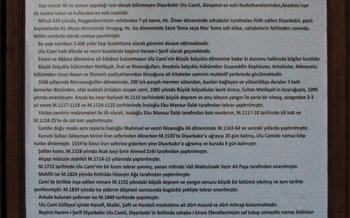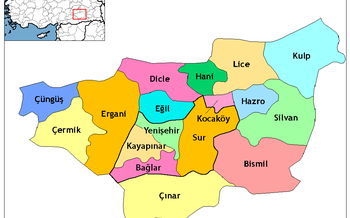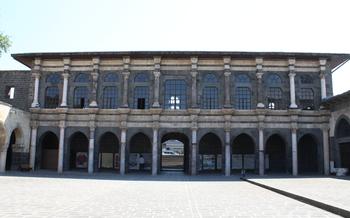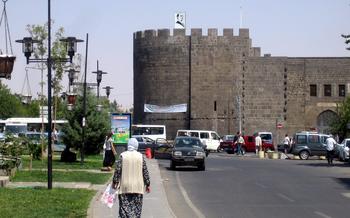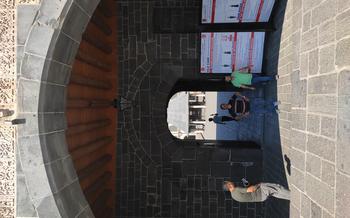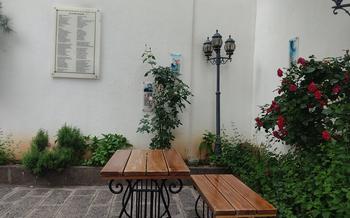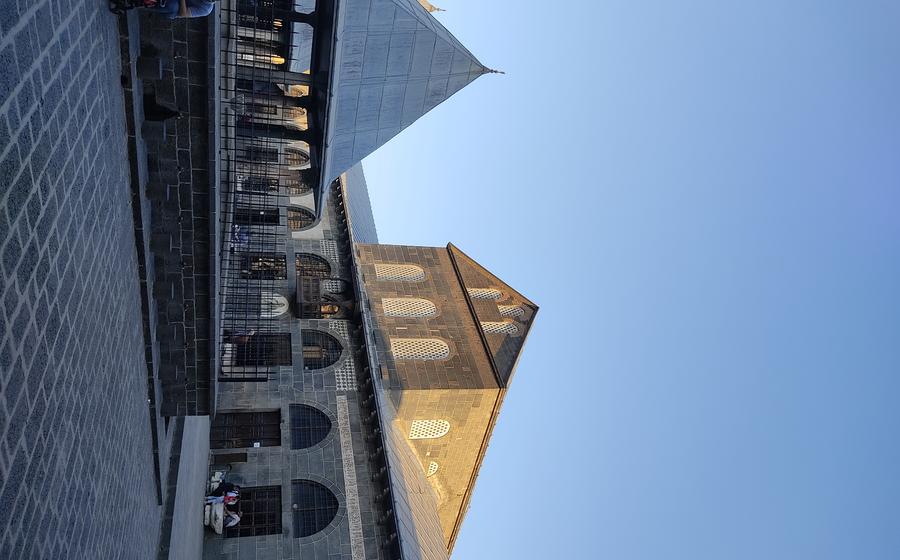
Diyarbakır Asur Bas Reliefs
- Diyarbakır Asur Bas Reliefs
- Historical Background:
- The Reliefs
- Location:
- Insider Tips:
- Practical Information:
- Cultural Significance:
- Historical Importance:
- Artistic Value
- Symbolism and Meaning
- Conservation and Preservation
- Tourism and Economic Impact
- Insider Tip: Take a Guided Tour of the Reliefs
Diyarbakır Asur Bas Reliefs
History of the reliefs:
The Diyarbakır Asur Bas Reliefs are a series of rock carvings that date back to the 8th century BC. They were created by the Neo-Assyrian Empire, which ruled over a vast territory in the Middle East for over two centuries. The reliefs depict scenes from the military campaigns of King Sennacherib, who was one of the most powerful and successful Assyrian rulers.
Location of the reliefs:
The reliefs are located on a rocky outcrop near the village of Ergani, about 50 kilometers northeast of the city of Diyarbakır. They are situated on the banks of the Tigris River, which was an important waterway for the Assyrians.
Significance of the reliefs:
The Diyarbakır Asur Bas Reliefs are significant for a number of reasons. First, they provide a valuable historical record of the Neo-Assyrian Empire. The reliefs depict scenes from the empire's military campaigns, as well as scenes from the royal court and everyday life. Second, the reliefs are a testament to the artistic skill and craftsmanship of the Assyrian sculptors. The reliefs are carved in great detail, and they depict a wide range of subjects, from human figures to animals to plants. Third, the reliefs are a source of national pride for the Assyrian people. The reliefs are a reminder of the Assyrians' rich history and culture, and they are a symbol of Assyrian identity.
Visiting information:
The Diyarbakır Asur Bas Reliefs are open to the public. Visitors can walk around the site and view the reliefs at their leisure. There is a small museum on the site that provides information about the reliefs and the history of the Neo-Assyrian Empire.
Historical Background:
The Neo-Assyrian Empire was a powerful and expansive empire that ruled over much of the Middle East during the 8th and 7th centuries BC. The empire was founded by King Ashurnasirpal II, who conquered vast territories and established the Assyrian capital at Nineveh. One of the most famous Assyrian kings was Sennacherib, who ruled from 705 to 681 BC. Sennacherib was a ruthless and ambitious ruler who conquered many lands and built magnificent palaces and temples. He is also known for his brutal campaign against the Kingdom of Judah, which he invaded and laid siege to the city of Jerusalem.
In 708 BC, Sennacherib turned his attention to the city of Diyarbakır, which was then known as Amida. Amida was a strategic city located on the trade route between Assyria and Anatolia. Sennacherib besieged the city and eventually conquered it, deporting many of its inhabitants and resettling them in other parts of the empire. The conquest of Amida was a significant victory for Sennacherib, as it secured his control over the region and opened up new trade routes to the west.
The Reliefs
The Diyarbakır Asur Bas Reliefs are a collection of intricate and well-preserved stone carvings that depict various scenes from Assyrian history and mythology. Carved into the rocky cliffs overlooking the Tigris River, the reliefs are a testament to the skill and artistry of the Assyrian sculptors. The most striking feature of the reliefs is their size; some of the panels are over 2 meters tall and depict complex scenes with dozens of figures. The reliefs are carved in a distinctive style, characterized by their deep, chiseled lines and attention to detail. The subject matter of the reliefs is diverse, ranging from battle scenes and hunting expeditions to religious ceremonies and royal processions. Some of the reliefs also feature inscriptions in cuneiform, providing valuable insights into Assyrian history and culture.
Location:
The Diyarbakır Asur Bas Reliefs are located on a massive rock outcropping in the southeastern part of the city, near the banks of the Tigris River. To reach the reliefs, you can take a taxi or public bus to the district of Sur and then walk or take a short ride to the site. The exact location of the reliefs is at the foot of the Diyarbakır Fortress, a UNESCO World Heritage Site, which offers stunning views of the city and the surrounding region. While visiting the reliefs, you can also explore the nearby attractions, such as the Grand Mosque of Diyarbakır, the Hasan Paşa Han, and the Diyarbakır Archaeological Museum.
Tips for Visiting the Reliefs:
- Wear comfortable shoes, as the path leading to the reliefs can be uneven.
- Bring a hat, sunglasses, and sunscreen, as the site is mostly exposed to the sun.
- Be respectful of the cultural significance of the reliefs and avoid touching or damaging them.
- If you are interested in learning more about the reliefs, consider hiring a local guide who can provide you with detailed explanations and insights.
Insider Tips:
-
Combine your visit to the Diyarbakır Asur Bas Reliefs with a tour of the iconic Diyarbakır Fortress. This impressive fortification, built by the Romans and expanded by the Byzantines and Seljuks, offers breathtaking panoramic views of the city and surrounding landscape. Explore its imposing walls, towers, and gates, and delve into the rich history that unfolds within its ancient stones.
-
For a deeper dive into the region's captivating past, make sure to visit the Museum of Diyarbakır. This treasure trove of history and culture houses an array of artifacts, including stunning sculptures, ancient pottery, and intricate textiles, that narrate the story of Diyarbakır's diverse heritage.
-
Take your time to fully appreciate the intricate details and artistry of the reliefs. Each panel, each figure, each symbol holds a story, a message, a glimpse into the past. Allow yourself to be transported back in time as you decipher the tales etched into the stone.
-
Remember to bring water and sunscreen, as the site is exposed and can be quite hot and sunny, especially during the summer months. Stay hydrated and protected to ensure a comfortable and enjoyable visit.
Practical Information:
Dress code: When visiting the Diyarbakır Asur Bas Reliefs, it is important to dress respectfully. While there is no specific dress code, it is recommended to wear modest clothing that covers your shoulders and knees.
Accessibility for disabled visitors: The site is wheelchair accessible, with ramps and elevators providing access to the reliefs. However, some of the paths leading to the reliefs may be uneven or cobbled, so it is advisable to exercise caution.
Photography and videography rules: Photography and videography are permitted at the site. However, the use of flash photography is prohibited, as it can damage the reliefs.
Nearby restaurants and cafes: There are several restaurants and cafes located near the Diyarbakır Asur Bas Reliefs. These offer a variety of cuisines, from traditional Turkish dishes to international fare.
Cultural Significance:
The Diyarbakır Asur Bas Reliefs hold immense cultural significance for the Assyrian people. These reliefs serve as a tangible reminder of their rich history, cultural heritage, and identity. They depict scenes from the Assyrian Empire, including military campaigns, religious rituals, and royal ceremonies. For the Assyrian community, these reliefs are a source of pride and a symbol of their enduring legacy.
The reliefs have played a pivotal role in promoting cultural understanding and fostering a sense of unity among Assyrians worldwide. Through exhibitions, publications, and educational programs, the reliefs have helped to raise awareness of the Assyrian culture and its contributions to world civilization. They have also served as a bridge between different cultures, allowing people from various backgrounds to appreciate the artistic and historical significance of the Assyrian Empire.
Historical Importance:
The Diyarbakır Asur Bas Reliefs are of immense historical importance as they provide a rich source of information about the Neo-Assyrian Empire and its military campaigns. The reliefs depict various scenes of warfare, conquest, and triumph, offering valuable insights into the military strategies, tactics, and weaponry of the Assyrian army. They also document the vast territorial extent of the Assyrian Empire, showcasing the conquered regions and cities that fell under its dominion.
Furthermore, the reliefs serve as a historical record of significant events and achievements during King Sennacherib's reign. They commemorate the Assyrian conquest of Diyarbakır and provide a visual account of the city's transformation into a provincial capital of the Neo-Assyrian Empire. Additionally, the reliefs shed light on the administrative and political systems of the Assyrian Empire, depicting scenes of tribute payments, royal processions, and the establishment of Assyrian authority over conquered territories.
The Diyarbakır Asur Bas Reliefs are invaluable historical artifacts that offer a glimpse into the past and contribute to our understanding of the Neo-Assyrian Empire, its military prowess, and its impact on the region. They provide a unique perspective on ancient Assyrian history and serve as a reminder of the empire's enduring legacy.
Artistic Value
The Diyarbakır Asur Bas Reliefs are not only of historical importance, but also of great artistic value. The reliefs are unique in their style and craftsmanship, and they display the skill and artistry of the Assyrian sculptors.
The reliefs are carved in a style that is both naturalistic and symbolic. The figures are depicted in a realistic manner, with attention to detail and proportion. However, the reliefs also contain symbolic elements, such as the winged bulls that represent the Assyrian god Ashur.
The craftsmanship of the reliefs is also impressive. The figures are carved with great precision and detail, and the overall composition of the reliefs is harmonious and well-balanced.
The Diyarbakır Asur Bas Reliefs are a testament to the artistic skill and creativity of the Assyrian people. They are a valuable asset to the cultural heritage of Turkey, and they continue to inspire and awe visitors from around the world.
Symbolism and Meaning
The Diyarbakır Asur Bas Reliefs are a treasure trove of symbolism and meaning. The imagery depicted in the reliefs is rich in religious, political, and cultural significance. Many of the reliefs depict scenes of Assyrian kings and their armies engaged in battle, which were intended to glorify the power and might of the Assyrian Empire. Other reliefs depict scenes of religious rituals and ceremonies, providing valuable insights into the religious beliefs and practices of the ancient Assyrians.
The reliefs also served as a form of propaganda, designed to intimidate and impress the enemies of the Assyrian Empire. The graphic depictions of violence and conquest were intended to send a clear message to potential adversaries: the Assyrians were a powerful and ruthless force to be reckoned with.
Beyond their political and military significance, the reliefs also have deep religious and cultural meaning. Many of the reliefs depict scenes from Assyrian mythology and folklore, providing valuable insights into the beliefs and values of the ancient Assyrian people. The reliefs also served as a way to commemorate important events and achievements in Assyrian history, such as the conquest of new territories or the construction of new temples.
Conservation and Preservation
The Diyarbakır Asur Bas Reliefs are of immense historical and cultural significance, and their preservation is of utmost importance. However, the reliefs have faced several challenges over the years, including erosion, vandalism, and neglect.
Erosion is a major threat to the reliefs, as the constant exposure to wind, rain, and sunlight has caused the stone to deteriorate. Vandalism has also been a problem, with some visitors defacing the reliefs with graffiti or other markings. In addition, the reliefs have suffered from neglect, as they were not properly maintained or protected for many years.
In recent years, there have been several initiatives to conserve and preserve the Diyarbakır Asur Bas Reliefs. The Turkish government has allocated funds for the restoration of the reliefs, and several international organizations have provided technical assistance and expertise.
One of the most significant conservation projects was the construction of a protective shelter over the reliefs. This shelter helps to protect the reliefs from the elements and from vandalism. In addition, the reliefs have been cleaned and restored, and a new lighting system has been installed to highlight their features.
Despite these efforts, there is still more work to be done to ensure the long-term preservation of the Diyarbakır Asur Bas Reliefs. Ongoing monitoring and maintenance are necessary to prevent further deterioration, and additional research is needed to better understand the best conservation methods for these unique and valuable artifacts.
Tourism and Economic Impact
The Diyarbakır Asur Bas Reliefs have become a significant tourist attraction, drawing visitors from around the world who are interested in history, archaeology, and art. The presence of these ancient carvings has played a crucial role in boosting tourism in the region, providing a source of income and economic growth for the local community.
The influx of tourists has led to the development of a thriving tourism industry in Diyarbakır. Hotels, restaurants, and tour operators have sprung up to cater to the needs of visitors, creating employment opportunities and stimulating economic activity. Moreover, the increased tourism has also contributed to the preservation and restoration of other historical sites in the area, further enhancing the region's cultural heritage and promoting sustainable development.
In addition to the direct economic benefits, tourism has also had a positive impact on the local culture and traditions. The presence of international visitors has fostered cross-cultural exchange and understanding, promoting tolerance and respect for diversity. This cultural interaction has led to a renewed appreciation for the region's rich history and heritage, contributing to the preservation and revitalization of local customs and traditions.
Overall, the Diyarbakır Asur Bas Reliefs have had a significant impact on tourism and the economy of the region. They have attracted visitors from around the world, generating income for the local community and contributing to sustainable tourism development. The presence of these ancient carvings has also contributed to the preservation of local culture and traditions, fostering cross-cultural exchange and understanding.
Insider Tip: Take a Guided Tour of the Reliefs
To fully appreciate the historical and cultural significance of the Diyarbakır Asur Bas Reliefs, consider taking a guided tour. Led by knowledgeable experts, these tours offer a deeper understanding of the reliefs' history, subject matter, and symbolism. Guides can provide insights into the Neo-Assyrian Empire, King Sennacherib's reign, and the reliefs' role in Assyrian propaganda and military campaigns. By participating in a guided tour, you'll gain a richer and more comprehensive experience, leaving you with a lasting appreciation for these remarkable works of art.

